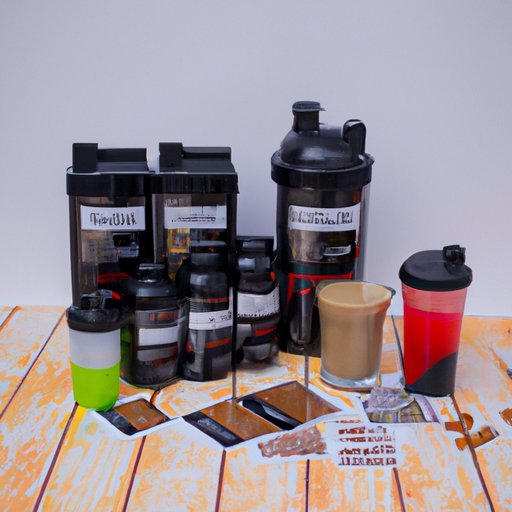Introduction
Protein is an essential macronutrient that plays an important role in many bodily functions. It is made up of amino acids, which are the building blocks of muscle, tissue, skin, hair, and nails. Eating enough protein can help to maintain a healthy weight, build muscle, and support overall health. The recommended daily allowance (RDA) of protein for the average adult is 0.8g per kilogram of body weight, or around 56g for a woman and 70g for a man.
For those looking to gain muscle mass or lose weight, however, 100g of protein a day is often recommended. Eating this much protein can be challenging, so it’s important to plan ahead and incorporate protein-rich foods into every meal and snack.
Plan a Day of High-Protein Meals
When aiming for 100g of protein a day, start by planning out your meals. Aim to include protein-rich foods at breakfast, lunch, and dinner. Here are some ideas for each meal:
Breakfast Ideas
At breakfast, focus on lean proteins such as eggs, Greek yogurt, cottage cheese, tofu, and tempeh. You can also add nuts and seeds to a smoothie or oatmeal for extra protein. Omelets and egg scrambles are also a great way to add protein to breakfast.
Lunch Ideas
For lunch, opt for a salad topped with grilled chicken, tuna, salmon, or other lean proteins. You can also make a wrap with hummus and vegetables, or a sandwich with nut butter and banana slices. Lentil soup, quinoa bowls, and veggie burgers are all great sources of protein, too.
Dinner Ideas
At dinner, you can enjoy lean proteins like steak, pork tenderloin, salmon, or chicken. You can also incorporate plant-based proteins such as quinoa, beans, lentils, and tempeh. If you’re having pasta, opt for whole wheat varieties and top with a protein-rich sauce or meatballs.
Incorporate Protein-Rich Snacks Throughout the Day
Snacking is a great way to increase your protein intake throughout the day. Here are some healthy snack options that are packed with protein:
Healthy Snack Options
Hard-boiled eggs, edamame, Greek yogurt, nut butters, and hummus with veggies are all great sources of protein. Avocado toast, roasted chickpeas, and cottage cheese are also good options. For a sweet treat, try a protein bar or homemade protein balls.
On-the-Go Snack Options
If you’re on the go, grab a handful of almonds, walnuts, or other nuts. Jerky, string cheese, and peanut butter packets are also good options for when you’re out and about. Greek yogurt and nut butter cups are also great portable snacks.
Make Protein Shakes or Smoothies
Shakes and smoothies are a great way to get extra protein in your diet. Here are some recipes for protein shakes and smoothies that you can make at home:
Recipes for Protein Shakes
To make a classic protein shake, blend together 1 scoop of protein powder, 1 cup of milk or non-dairy milk, 1/2 cup of frozen fruit, and 1 tablespoon of nut butter. For an extra boost, add 1 teaspoon of chia seeds or flaxseeds.
Recipes for Protein Smoothies
For a protein-packed smoothie, blend together 1 scoop of protein powder, 1 cup of non-dairy milk, 1/2 cup of frozen fruit, 1 tablespoon of nut butter, and 1/4 cup of oats. You can also add 1 teaspoon of superfoods such as spirulina, chlorella, or maca powder.
Choose Protein-Dense Foods
In addition to shakes and smoothies, there are plenty of other protein-dense foods that you can incorporate into your diet. Here are some of the best sources of protein:
Meat and Seafood
Lean meats such as chicken, turkey, and beef are all excellent sources of protein. Fish like salmon, tuna, and cod are also great options. Shellfish like shrimp, crab, and lobster are also high in protein.
Dairy Products
Dairy products such as milk, yogurt, and cheese are all good sources of protein. They also provide calcium, which is important for bone health. Choose low-fat or non-fat varieties for maximum health benefits.
Nuts and Seeds
Nuts and seeds are packed with protein and heart-healthy fats. Almonds, walnuts, cashews, pistachios, sunflower seeds, chia seeds, and flaxseeds are all great options. Nuts and seeds make a great snack or topping for salads and yogurt.
Legumes and Beans
Legumes and beans are excellent sources of plant-based protein. Chickpeas, lentils, black beans, kidney beans, and lima beans are all good options. You can add them to salads, soups, and stews, or mash them up to make a dip or spread.
Track Your Protein Intake
Tracking your food and protein intake can be helpful in reaching your goals. Here are some of the benefits of tracking and some tools that can help:
Benefits of Tracking
Tracking your food intake can help you stay accountable and ensure that you are getting enough protein each day. It can also be useful for finding patterns in your eating habits that may need to be adjusted in order to reach your goals.
Tools for Tracking
There are several apps and websites that can help you track your food and protein intake. Some popular ones are MyFitnessPal, LoseIt!, and Cronometer. These tools allow you to set goals, log your meals, and track your progress.
Conclusion
Eating 100g of protein a day can be challenging, but it’s possible with the right plan. Start by planning out your meals and snacks and incorporating protein-rich foods throughout the day. Make sure to track your intake to stay on track and reach your goals. With a little bit of planning, you can easily meet your protein needs.
(Note: Is this article not meeting your expectations? Do you have knowledge or insights to share? Unlock new opportunities and expand your reach by joining our authors team. Click Registration to join us and share your expertise with our readers.)
